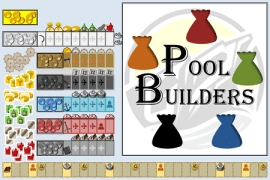 We’re diving into one of our recent favorites this week as Orléans was our top “new to us” game on the site for 2015. Since then, our opinions have drifted in different directions and we thought it would be fun to look at how the game has aged for us only a few years later.
We’re diving into one of our recent favorites this week as Orléans was our top “new to us” game on the site for 2015. Since then, our opinions have drifted in different directions and we thought it would be fun to look at how the game has aged for us only a few years later.
If this is your first time visiting Games Precipice, our focus is on game design theory and ideas that can make games great. In writing about Orléans, the large majority of our conversation is a deep dive into this brilliant game applying the game design frameworks we’ve been writing about recently. To help frame the discussion, this is more than just a write-up about Orléans; this is an article about Orléans in the greater conversation of pool building games. So let’s jump right in.
Prototypical Pool Building
 Orléans is best classified as a bag building game and it shares a number of familiar concepts with a deck building game like Dominion or a dice building game like Quarriors. We recently covered these various mechanics collectively in a series on pool building games.
Orléans is best classified as a bag building game and it shares a number of familiar concepts with a deck building game like Dominion or a dice building game like Quarriors. We recently covered these various mechanics collectively in a series on pool building games.
Despite the similarities on the surface, these games can be tricky to break down as a group. One approach we’ve taken to look in-depth at these mechanics has been to identify the common skills and tasks players are carefully considering while building their deck in Ascension or filling their bag in Orléans.
In Pool Builders… players manage long-term efficiency
A common bond among pool building games is that these mechanics relay a marathon mentality to players. Orléans is a game of putting one foot ahead of the other in order to string together a strategy over the long-term. By the end of the game, a player will rarely be able to pinpoint the exact moment or turn that pushed them toward victory, since each turn the player moves the needle forward just enough to see observable progress in a race of efficiency.


 To wrap up our mechanic archetype series on pool builders, I’m going to trace a history of builders and try to hit the highlights of some of the most important developments in builders. Naturally, it’s impossible to describe every single strategy game that has ever used a builder mechanic, but I’ll aim to analyze the modern builder lineage and try to anticipate some innovations in the future of the format.
To wrap up our mechanic archetype series on pool builders, I’m going to trace a history of builders and try to hit the highlights of some of the most important developments in builders. Naturally, it’s impossible to describe every single strategy game that has ever used a builder mechanic, but I’ll aim to analyze the modern builder lineage and try to anticipate some innovations in the future of the format. The most important and far-reaching mechanical innovation of Magic: the Gathering was that it introduced both variance and a means to mitigate that variance in the same mechanic. In any format of Magic, you’re responsible for creating a deck and drawing cards at random from it during the game.
The most important and far-reaching mechanical innovation of Magic: the Gathering was that it introduced both variance and a means to mitigate that variance in the same mechanic. In any format of Magic, you’re responsible for creating a deck and drawing cards at random from it during the game. It might be trite to describe
It might be trite to describe  We launched a new series over the past year of what we call “Mechanic Archetypes”, an opportunity to examine mechanic-by-mechanic what differentiates successful game designs from the rest when we’re thinking about ones that fall under a label, such as
We launched a new series over the past year of what we call “Mechanic Archetypes”, an opportunity to examine mechanic-by-mechanic what differentiates successful game designs from the rest when we’re thinking about ones that fall under a label, such as  Our latest topic is “Pool Builders”, a collection of related mechanics like Deck Builders, Dice Builders and Bag Builders that are worth exploring side-by-side as they tend to share similar strengths, weaknesses and approaches to game design.
Our latest topic is “Pool Builders”, a collection of related mechanics like Deck Builders, Dice Builders and Bag Builders that are worth exploring side-by-side as they tend to share similar strengths, weaknesses and approaches to game design. We’ve been exploring Worker Placement over the last month, creating a
We’ve been exploring Worker Placement over the last month, creating a  Stone Age
Stone Age Dominant Species
Dominant Species In a hobby with with so many divisive subjects, we can hardly agree on a definition for Worker Placement. Earlier this month,
In a hobby with with so many divisive subjects, we can hardly agree on a definition for Worker Placement. Earlier this month,